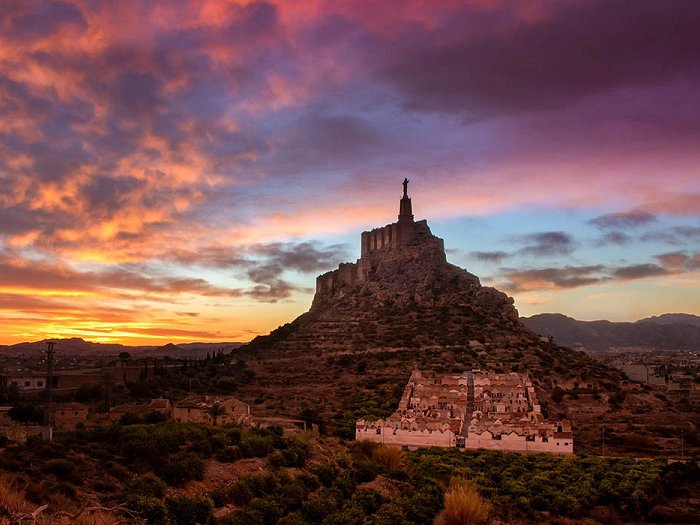
As a property owner at La Manga Club, you are perfectly positioned to explore the wonders of *medieval Murcia*—a region full of castles, churches, and city squares that offer a captivating journey into the past. While this southeastern corner of Spain is celebrated for its beautiful beaches, warm climate, and exceptional cuisine, it also holds a rich historical legacy that is well worth discovering.
Murcia’s origins date back to 825AD, during the reign of Abd ar-Rahman II, a period that left a lasting mark on the region through both Arab and Christian influences. Under Muslim rule, the city thrived as a key trading center, known for its sophisticated irrigation systems. Following the Reconquista in 1243, Murcia became part of the Crown of Castile, ushering in a new era of cultural and architectural development. Today, the city’s old town is a testament to this vibrant history, with its winding streets, picturesque squares, and remarkable monuments.
The Castle of Monteagudo
For owners at La Manga Club who have a passion for history and a love of nature and are looking for places to visit, the “Route of the Fortresses” is not to missed. Just 40 minutes from the resort, this excursion offers the opportunity to explore medieval Murcia fortresses, including the castles of Lorca, Mula, and Monteagudo.
The latter is one of the most emblematic of Murcia’s medieval period and stands on a rocky hill offering breathtaking panoramic views of the surrounding region. Originally constructed by the Muslims in the 11th century and later expanded by the Christians after the Reconquista, the castle is not only a marvel of architecture but also a site of significant military history. It played a crucial role in the defence of the territory during Muslim rule and later served as a royal residence and strategic military outpost under Christian rule.
The Walls of Murcia
The ancient walls of Murcia are a compelling reminder of the city’s rich medieval heritage. Initially built by the Muslims in the 9th century and later reinforced by the Christians, these walls were integral to the city’s defense. Today, several sections of these historic walls have been carefully restored and preserved, allowing visitors to appreciate their historical importance.
One of the most prominent sections is located near the Puerta de Santa Eulalia, one of the main entrances to the city during the Middle Ages. This well-preserved section offers a unique glimpse into the evolution of Murcia’s urban defences, showing how they were adapted and improved over the centuries. It is an essential visit for anyone interested in the city’s history and architecture.
Another site of interest is Veronica’s Wall, adjacent to the market of the same name. Dating back to the 11th to 13th centuries, this defensive structure features towers, a walkway, and a barbican. Part of the wall is incorporated into Veronica’s Church, offering a fascinating example of how these fortifications were integrated into subsequent architectural developments. Nearby, a café in Plaza de Veronica provides a unique setting to enjoy a meal or drink while overlooking the remnants of the medieval wall.
The Cathedral of Santa María and Its Museum
A visit to Murcia would be incomplete without exploring the Cathedral of Santa María. Built on the site of the city’s former main mosque, the cathedral is a powerful symbol of the transition from Muslim to Christian rule. Its construction began in 1394 and spanned several centuries, resulting in a stunning blend of architectural styles, from Gothic to Baroque.
The imposing bell tower of the cathedral, which measures 93 meters high, is one of the tallest in Spain and offers spectacular panoramic views of the city. Inside, be sure to visit the Vélez Chapel, a masterpiece of flamboyant Gothic design, and the Cathedral Museum, where a wealth of sacred art is on display.
The Jewish Quarter
In addition to its Arab and Christian heritage, medieval Murcia was home to a thriving Jewish community. The Barrio de la Judería, nestled in the old town, is a testament to this rich cultural history. Walking through its narrow, cobbled streets, one can still sense the presence of the past in buildings that retain elements of medieval architecture.
Among the quarter’s highlights is the site of the Murcia Synagogue. Though not fully intact, the remnants of this synagogue serve as a poignant reminder of the Jewish community’s importance in the region. The area is also known for its artisanal shops and restaurants, where visitors can enjoy local cuisine influenced by Jewish and Muslim traditions.
There is no better way to truly appreciate a place than by immersing yourself in its history and culture. From your home at La Manga Club, you have the ideal starting point for this journey through medieval Murcia. Let experienced local guides lead you through the architectural marvels and landscapes, sharing the legends and stories that bring this ancient region to life.
Recent posts
-
08/12/25
Celebrate the 1200th anniversary of the city of Murcia from your property at La Manga Club
- 10/11/25
- 23/10/25
-
14/09/25
Thinking of buying property at La Manga Club? These 7 insights might just convince you
-
10/08/25
Looking for a day out from your home at La Manga Club? Visit the Ricote Valley and Cieza
-
18/07/25
Las Acacias: Buying a Luxury Villa in Spain’s Premier Golf Resort
-
23/06/25
Buying Property in La Manga Club: Discover the 5 Must-See Highlights of the Calblanque Regional Park
-
15/05/25
Dive just minutes from your La Manga Club home: the Islas Hormigas Marine Reserve